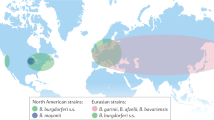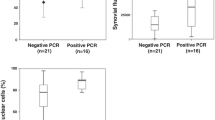Abstract
To investigate ifBorrelia burgdorferi can persist in resident joint cells, an infection model using cell cultures of human synovial cells was established and compared to the interaction ofBorrelia burgdorferi and human macrophages.Borrelia burgdorferi were found attached to the cell surface or folded into the cell membrane of synovial cells analysed by transmission electron and confocal laser scanning microscopy. In contrast to macrophages, morphologically intactBorrelia burgdorferi were found in the cytosol of synovial cells without engulfment by cell membrane folds or phagosomes.Borrelia burgdorferi were isolated from parallel cultures. Treatment with ceftriaxone eradicated extracellularBorrelia burgdorferi, but spirochetes were reisolated after lysis of the synovial cells.Borrelia burgdorferi persisted inside synovial cells for at least 8 weeks. These data suggested thatBorrelia burgdorferi might be able to persist within resident joint cells in vivo.
Similar content being viewed by others
References
Burgdorfer W, Barbour AG, Hayes SF, Benach JL, Grunwaldt E, Davis JP (1989) Lyme disease — a tick-borne spirochetosis? Science 216:1317–1319
Steere AC (1989) Lyme Disease. N Engl J Med 321:586–596
Huppertz HI, Karch H, Suschke HJ, Döring E, Ganser G, Thou A, Bentas W (1995) Lyme arthritis in European children and adolescents. Arthritis Rheum 38:361–368
Krause A, Brade V, Schoerner C, Solbach W, Kalden JR, Burmester GR (1991) T cell proliferation induced byBorrelia burgdorferi in patients with Lyme borreliosis. Arthritis Rheum 34:393–402
Dressler F, Whalen JA, Reinhardt BN, Steere AC (1993) Western blotting in the sero diagnosis of Lyme arthritis. J Infect Dis 167:392–400
Szczepanski A, Benach JL (1991) Lyme borreliosis: host response toBorrelia burgdorferi. Microbiol Rev 55:21–34
Georgilis K, Steere AC, Klempner MS (1991) Infectivity ofBorrelia burgdorferi correlates with resistances to elimination by phagocytic cells. J Infect Dis 163:150–155
Szczepanski A, Fleit HB (1988) Interaction betweenBorrelia burgdorferi and polymorphonuclear leukocytes-phagocytosis and the induction of the respiratory burst. Ann NY Acad Sci 539:425–428
Rittig MG, Krause A, Häupl T, Schaible UE, Modolell M, Kramer MD, Lutjen-Drecoll E, Simon MM, Burmester GR (1992) Coiling phagocytosis is the preferential phagocytic mechanism forBorrelia burgdorferi. Infect Immun 60:4205–4212
Steere C, Duray PH, Butcher EC (1988) Spirochetal antigens and lymphoid cell surface markers in Lyme arthritis. Arthritis Rheum 31:487–495
Nocton JJ, Dressler F, Rutledge BJ, Rys PN, Persing DH, Steere AC (1994) Detection ofBorrelia burgdorferi DNA by polymerase chain reaction in synovial fluid from patients with Lyme arthritis. N Engl J Med 330:229–234
Hulinska D, Jirous J, Valesova M, Herzogova J (1989) Ultrastructure ofBorrelia burgdorferi in tissues of patients with Lyme disease. J Basic Microbiol 29:73–83
Häupl T, Hahn G, Rittig M, Krause A, Schoerner Ch, Schiinherr U, Kalden JR, Burmester GR (1993) Persistence ofBorrelia burgdorferi in ligamentous tissue from a patient with chronic Lyme borreliosis. Arthritis Rheum 36:1621–1626
Snydman DR, Schenkein DP, Beradi VP, Lastavica CC, Pariser KM (1986)Borrelia burgdorferi in joint fluid in chronic Lyme arthritis. Ann Intern Med 104:798–800
Huppertz HI, Chantler JK (1991) Restricted mumps virus infection of cells derived from normal human joint tissue. J Gen Virol 72:339–347
Huppertz HI (1994) How could infectious agents hide in synovial cells? Possible mechanisms of persistent viral infection in a model for the etiopathogenesis of chronic arthritis. Rheumatol Int 14:71–76
Radzun HJ, Kreipe H, Bödewadt S, Hausmann ML, Barth J, Parwaresch MR (1987) Ki-M8 monoclonal antibody reactive with an intracytoplasmatic antigen of monocyte/macrophage lineage. Blood 69:1320–1370
Papadopoulos Th, Ionescu L, Dämmrich J, Toomes H, Müller-Hermelink HK (1990) Type I and type II collagen promote adherence and spreading of type II pneumocytes in vitro. Lab Invest 62:562–569
Huppertz HI, Karch H, Heeseman J (1995) Diagnostic value of synovial fluid analysis in children with reactive arthritis. Rheumatol Int 15:167–170
Preac-Mursie V, Wilske B, Scherz G, Holmburger M, Suss E (1987) In vitro and in vivo susceptibility ofBorrelia burgdorferi. Eur J Clin Microbiol 6:424–426
Sigal LH (1992) Current recommendations for the treatment of Lyme disease. Drugs 43:683–699
Probst P, Reusser P, Fröscher R (1987) Synoviapenetration von Ceftriaxon in der othopddischen Chirurgie. Abstract no. 40, 15th International Congress of Chemotherapy, Istanbul
Ma Y, Sturrock A, Weiss JJ (1991) Intracellular localization ofBorrelia burgdorferi within human endothelial cells. Infect Immun 59:671–678
Comstock LE, Thomas DD (1989) Penetration of endothelial cell monolayers byBorrelia burgdorferi. Infect Immun 57:1626–1628
Sadziene A, Barbour AG, Rosa PA, Thomas DD (1993) An Osp B mutant ofBorrelia burgdorferi has reduced invasiveness in vitro and reduced infectivity in vivo. Infect Immun 61:3590–3596
Georgilis K, Peacocke M, Klempner MS (1992) Fibroblasts protect the Lyme disease spirochete,Borrelia burgdorferi, from ceftriaxone in vitro. J Infect Dis 166:440–444
Klempner MS, Noting R, Rogers RA (1993) Invasion of human skin fibroblasts by the Lyme disease spirochete,Borrelia burgdorferi. J Infect Dis 167:1074–1081
Schmidli J, Hunziker T, Moesli P, Schaad UB (1988) Cultivation ofBorrelia burgdorferi from joint fluid three months after treatment of facial palsy due to Lyme borreliosis. J Infect Dis 158:905–906
Persing DH, Rutledge BJ, Rys PN, Podzorski DS, Mitchell PD, Reed KD, Liu B, Fikrig E, Malawista SE (1994) Target imbalance: disparity ofBorrelia burgdorferi genetic material in syn ovial fluid from Lyme arthritis patients. J Infect Dis 169:668–672
Karch H, Huppertz HI (1993) Repeated detection ofBorrelia burgdorferi DNA in synovial fluid of a child with Lyme arthritis. Rheumatol Int 12:227–230
Chary-Valckenaere I, Jaulhac B, Monteil H, Pourel J (1993) Diagnosis of Lyme disease. Current difficulties and prospects. Rev Rheum Engl Ed 62:271–280
Author information
Authors and Affiliations
Corresponding author
Rights and permissions
About this article
Cite this article
Girschick, H.J., Huppertz, H.I., Rüssman, H. et al. Intracellular persistence ofBorrelia burgdorferi in human synovial cells. Rheumatol Int 16, 125–132 (1996). https://doi.org/10.1007/BF01409985
Received:
Accepted:
Issue Date:
DOI: https://doi.org/10.1007/BF01409985




